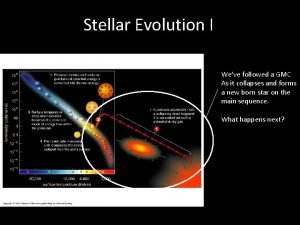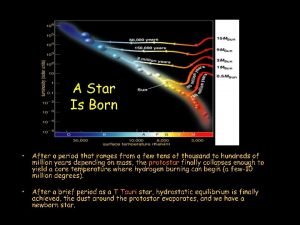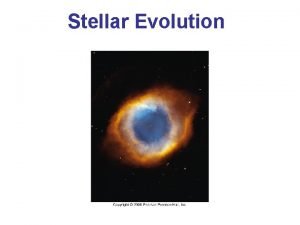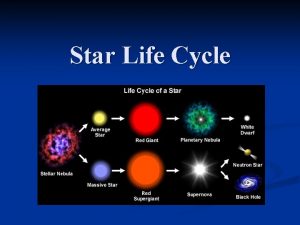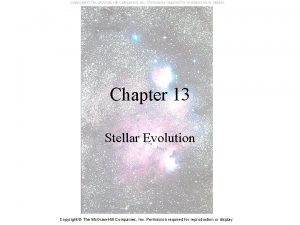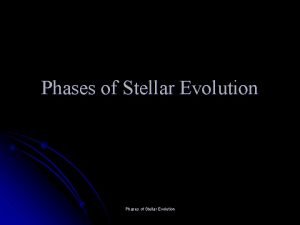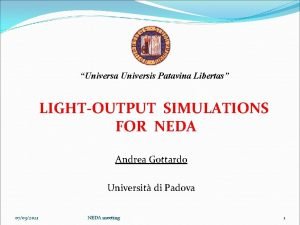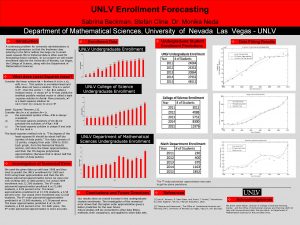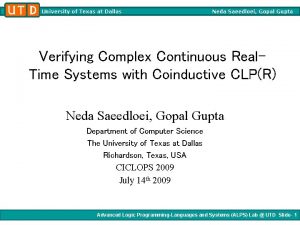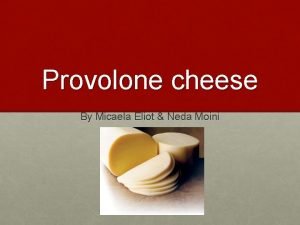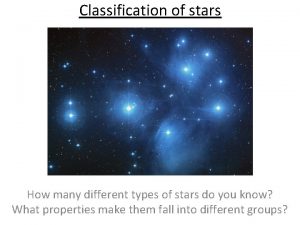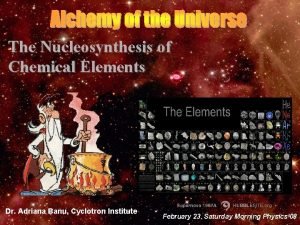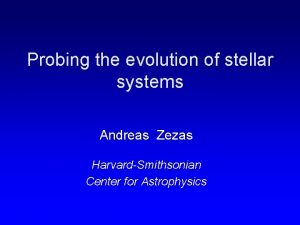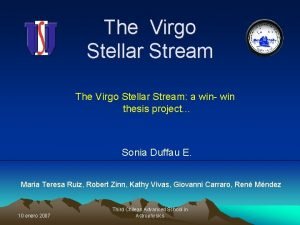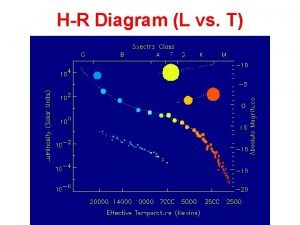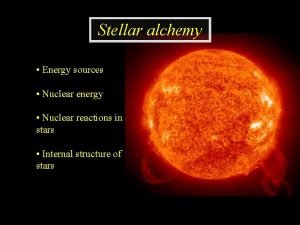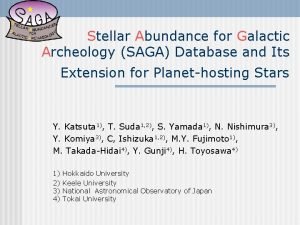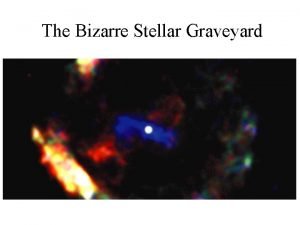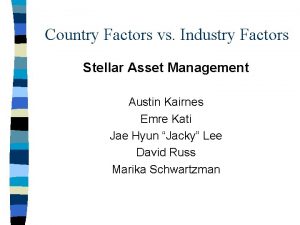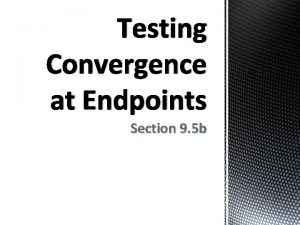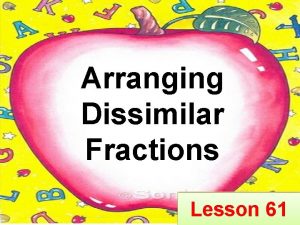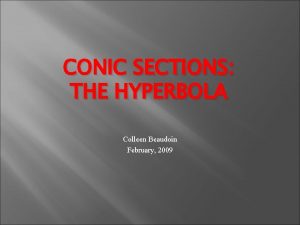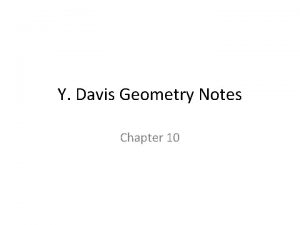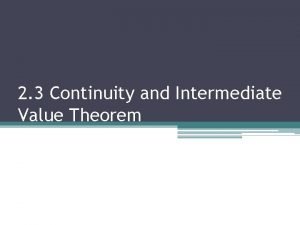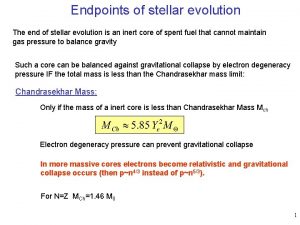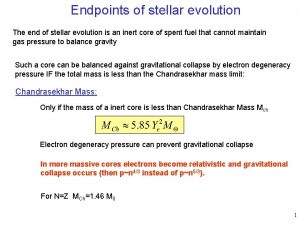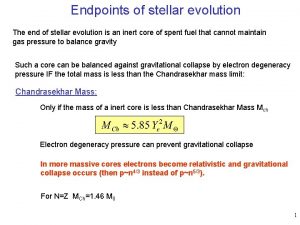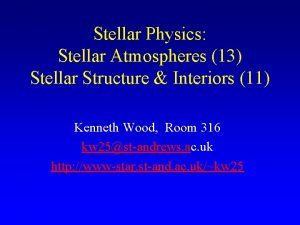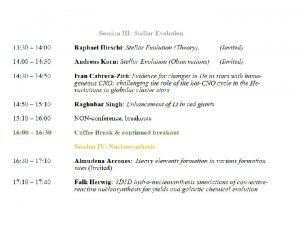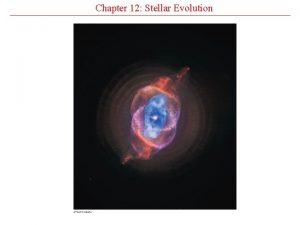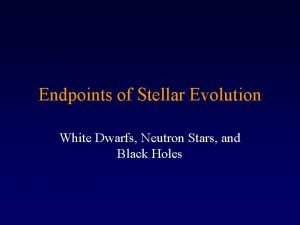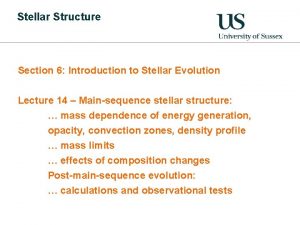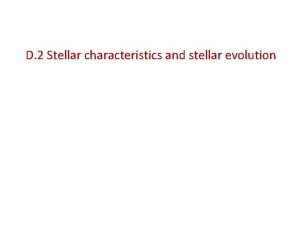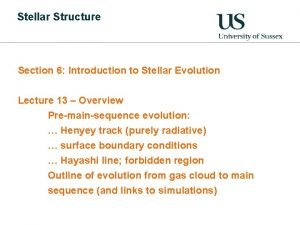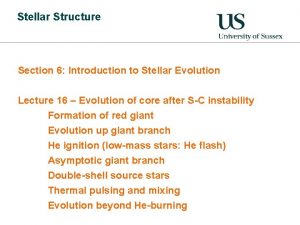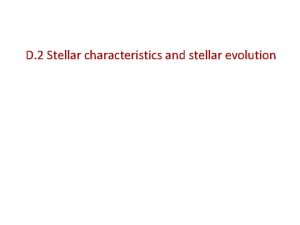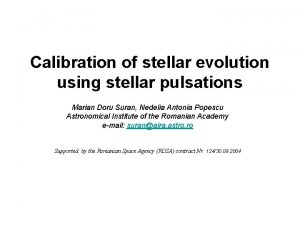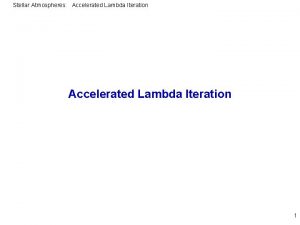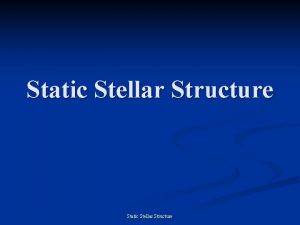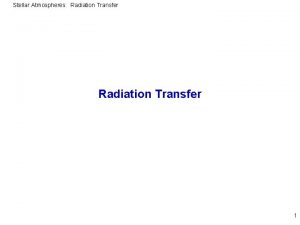Endpoints of Stellar Evolution Neda Hejazi April 2017
















































- Slides: 48

Endpoints of Stellar Evolution Neda Hejazi April, 2017

Proto-PNe and PNe Ø PPNe: Post AGB stars ✪ Intermediate-mass stars evolved from AGB ✪ Ejecting shell of gas and dust ✪ Mass loss and core contraction Ø CSPNe: Central stars of PNe Spectra: ✪ Subdwarf O-type stars ✪ Wolf-Rayet stars (WO, WC) ✪ Very hot proto-white dwarfs WHITE DWARF STARS Red Rectangle (HD 44179)

WD: The most common Endpoint of Stellar Evolution

Historical Notes on WD Ø Friedrich Bessell (1844) ✺ Proper motion of Sirius and Procyon wobble ✺ Suggested they orbited “dark stars” Ø Alvan Clark (1862) ✺ Discovered Sirius B ✺ Northwestern’s Dearborn Observatory Ø John M. Schaeberle (1896) ✺ Discovered Procyon B ✺ Lick Observatory

Historical Notes on WD •

Historical Notes Ø First WD systematic classification by G. Kuiper in 1941 ✰ Prefix “w” for signifying a WD ✰ “A type” : hydrogen lines ✰ “F type”: Ca II lines ✰ “G type”: weaker metallic blends ✰ “Con type”: featureless spectrum Ø Luyten 1952 ✰ Changing prefix “w” to “D” ✰ “B type”: only He I ✰ Adding a numeric subtype to indicate temperature

Historical Notes •

Current Classification Updated version from Mc. Cook & Sion 1999 D: degenerate star A, B, C, O, Z or Q: Primary spectroscopic characteristic

Current Classification •

Current Classification: DA Broad Balmer lines become sharper and weaker, as Teff decreases, almost disappearing around DA 10

Current Classification: DB

Current Classification: DZ Prominent Ca II H & K lines weaken as Teff decreases

Current Classification Ø Surface gravity Index: Early indicators of the line widths: ✾“d” for diffuse due to high gravity ✾“n” for narrow or “s” for sharp due to low gravity Recent numeric indicators: Example: DB 1. 3_ 7. 9 ✾A WD with a temperature of about 38, 800 K and a log g of 7. 9 ✾Further refinement half-integer indices for temperature Ø “Dusty DAZ” WD ✾IR excess ✾Photospheric Balmer lines and metal lines surrounded by dusty disk DAZd ( “d”: circumstellar dust)

Why WDs in UV? •

A comprehensive NUV and FUV study of the Hot DA WD G 191 -B 2 B by FUSE Preval et al. 2013

A comprehensive NUV and FUV study of the Hot DA WD G 191 -B 2 B by HST/STIS Preval et al. 2013

A comprehensive NUV and FUV study of the Hot DA WD G 191 -B 2 B by HST/STIS and FUSE Ø Preval et al. 2013 Ø https: //archive. stsci. edu/prepds/wd-linelist/

Cataclysmic Variables Interacting Binaries •

Cataclysmic Variables Interacting Binaries Ø Helium CVs: mass transfer of helium-rich material to WD instead of hydrogen-rich material Ø Polar variables: with strong magnetic field, accretion disk does not form, funneling the accreted mass onto a spot (a magnetic pole) on the surface of the WD, WD spin is synchronized with the orbital period of accreting material Ø Intermediate polars: weaker magnetic field, forming a partial accretion disk, WD spinning more rapidly than the orbital period of the disk

Novae Ø Nova explosion observed as a sudden brightness, followed by a decline Classical Novae: Having only one recorded outburst Recurrent Novae: Having more than one nova outburst Recurrence period: a few years to a few decades Ø Extending the monitoring time to hundreds or thousands of years All novae would be seen to erupt over and over!

Classical Novae •

Novae

Novae

Novae: Model •

May Become Dwarf Nova: Disk Instability Ø Causing regular, low amplitude bright phases Ø Termed: dwarf nova outbursts Ø Example: SS Cyg ✤ Going through a CV-type outburst ✤ Brightening the system from V=12 to V=8 The data from the American Association of Variable Star Observer (AAVSO)

Novae: Accreted Envelope • Increasing T Temperature rise gets out of control Thermo Nuclear Runaway (TNR)

Novae: Expanding Shell •

Novae: Remaining Accreted Material •

Novae: Speed Classification Ø Classified depending on the time taken to decline by two magnitudes from outburst maximum: “t 2” ØVery fast: t 2 < 10 days Ø Fast: t 2 = 11 -25 days Ø Moderately fast: t 2= 26 -80 days ØSlow: t 2= 81 -150 days ØVery slow: t 2= 150 -250 days Smooth light curves Irregular light curves

Novae: Speed Classification Featureless light curve of a fast nova Irregular light curve of a slow nova

Nova: Outburst Spectrum Ø Clear signature of a TNR and an expanding material Ø The evolution of the photosphere, wind and surface nuclear reactions Ø Dominated by permitted, recombination lines during the initial stages: low-ionization levels Ø Increasing ionization level with time Layers closer to the ionizing source (central WD) revealed as the ejecta expands Ø Forbidden lines at later stages: high-ionization levels Ø Decreasing ionization level in post-outburst quiescence phase

Nova: Spectral Classification Ø Old classification system: Mc. Laughlin 1960 ✽ Pre-maximum ✽ Principal ✽ Diffuse enhanced ✽ Orion ✽ Nubular ✽ Post nova ØA more versatile classification system: Williams et al. 1991; 1994 ✽ Based on the Cerro Tololo Nova Survey from 1987 to 1994 ✽ aka: “Tololo Nova Spectral Classification System” ✽ Concentrating on post-outburst spectra ✽ No Spectra at maximum light were obtained in the Tololo system

Nova: Photographic Spectra at Maximum Payne-Gaposchkin 1957 and Mc. Laughlin 1960 Ø Example: V 603 Aql, DQ Her and Nova Pictoris Ø Having absorption lines resembled A or F supergiants: Interesting! Ø Williams et al. 1991: ★ Is the max-light spectrum a purely absorption spectrum? ★ Weak emission lines might have suppressed in photographic spectra! ★ Their spectra show emission features shortly after max light

• Nova: Tololo Spectral Classification Early Phase

Nova: Tololo Spectral Classification Evolutionary Phases •

Nova: Tololo Spectral Classification Phases: Subclasses Phase C: Coronal Subscript Phase P: Permitted Phase A: Auroral Phase N: Nebular Superscript

Cen 1991: Fe IIn Nova

Sgr 1991: He/N Nova

V 2362 Cygni: Fe II nova

V 2491 Cygni: He/N nova

Other CVs: Recurrent and Dwarf Novae Looking like an M-giant with superimposed Balmer emission lines Emission Spectrum Absorption Spectrum Recurrent nova at quiescence Dwarf nova during outburst

Supernovae •

Supernovae: Classification • Early times ✿ Type Ia: a complex of Fe and Co emission lines due to forbidden transitions indicating SNe have entered the nebular phase ✿ Type Ib and Ic : Dominated by strong emission features due to elements: C I, O I, Mg I, Na I and Ca II ✿ Type Ib and Ic : difficult to distinguish as He I lines in Ib fade with time

Supernovae: Classification Subtypes For Type II Based on appearance in the light curve Ø IIL: a single maximum followed by a fairly steep but linear (L) decline, less deep after 100 days but still linear Ø IIP: a distinct plateau (P) shortly after the maximum, 1 mag below maximum, followed by a short, steep decline before a shallower linear decline Based on spectral diversity Ø IIn: Typical early-time Type characterized by broad lines, but a subset show much narrower lines (n) Ø IIb: Spectra evolving to resemble those of type Ib, having strong hydrogen lines at early times that are relatively weak at later times, implying a thin Hydrogen envelope

Supernovae: Classification

Supernovae: Classification Early Times

Supernovae: Classification Late Times

Supernovae: Classification Subtypes For Type II
 Vahid hejazi
Vahid hejazi Stellar evolution
Stellar evolution Life cycle of a star poster
Life cycle of a star poster Hr diagram
Hr diagram Stellar evolution
Stellar evolution Stages of stellar evolution of a low-mass star
Stages of stellar evolution of a low-mass star Stellar evolution
Stellar evolution Stellar evolution diagram
Stellar evolution diagram Neda soydan
Neda soydan Ettaedu prijava
Ettaedu prijava Neda moini
Neda moini Universa universis patavina libertas
Universa universis patavina libertas Sabrina cline
Sabrina cline Neda alipanah
Neda alipanah Neda soydan
Neda soydan Stojanovi
Stojanovi Qa neda wall
Qa neda wall Neda saeedloei
Neda saeedloei Neda ratanawongsa
Neda ratanawongsa Ivfet
Ivfet Neda moini
Neda moini History of provolone cheese
History of provolone cheese Neda ibrahim
Neda ibrahim Neda jafar
Neda jafar Stellar flux
Stellar flux What is stellar parallax?
What is stellar parallax? Stellar hosting iptv
Stellar hosting iptv Becquerel
Becquerel Stellar motion matlab
Stellar motion matlab Stellar
Stellar Stellar wifi
Stellar wifi Stellar assessment
Stellar assessment Virgo stellar stream
Virgo stellar stream Stellar formation
Stellar formation Stellar heaven
Stellar heaven Stellar alchemy
Stellar alchemy Stellar saga
Stellar saga Stellar graveyard
Stellar graveyard Stellar asset management
Stellar asset management Testing endpoints for convergence
Testing endpoints for convergence Physical devices of a computer
Physical devices of a computer Changing dissimilar fraction to similar fraction
Changing dissimilar fraction to similar fraction Facts about hyperbola
Facts about hyperbola The shortest arc connecting two endpoints on a circle
The shortest arc connecting two endpoints on a circle The coordinates of the endpoints of qr
The coordinates of the endpoints of qr Two collinear rays that do not intersect
Two collinear rays that do not intersect Continuity at endpoints
Continuity at endpoints Parallel perpendicular and intersecting lines song
Parallel perpendicular and intersecting lines song A segment whose endpoints
A segment whose endpoints

